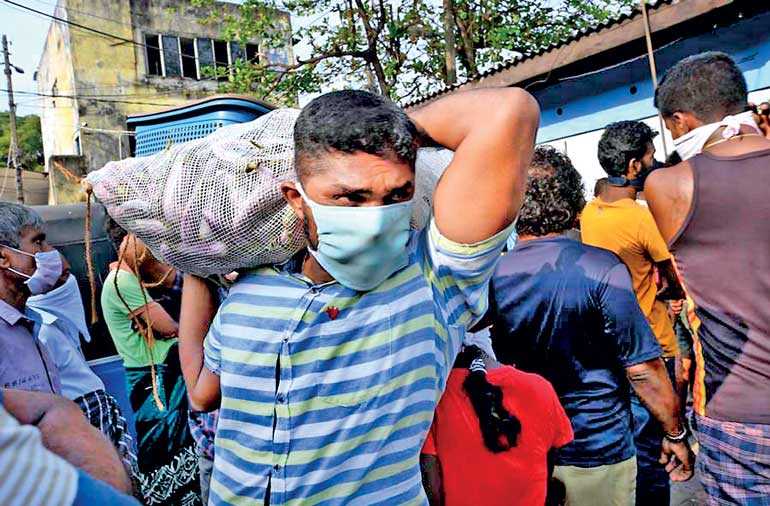Friday Jan 02, 2026
Friday Jan 02, 2026
Tuesday, 19 May 2020 00:30 - - {{hitsCtrl.values.hits}}

The closure of wholesale markets was preceded by scenes of massive oversupply, frustrated farmers throwing away unsold produce in large quantities, claims that the traditional traders were exploitative “middlemen,” and counterclaims that politicians were seeking to replace them with their own middlemen, and so on – Pic by Shehan Gunasekara
The COVID crisis
It is when something breaks that we notice. The curfews imposed at short notice to flatten the curve of COVID-19 infections damaged the food supply chains that Sri Lankan consumers had taken for granted since the demise of ration books that were central to our existence until the 1980s.
Since 2006, LIRNEasia has been studying fruit and vegetable supply chains in Sri Lanka centred on Sri Lanka’s largest wholesale market in Dambulla which was recently shut down by the Government along with several other wholesale markets. 
The closures were preceded by scenes of massive oversupply, frustrated farmers throwing away unsold produce in large quantities, claims that the traditional traders were exploitative “middlemen,” and counterclaims that politicians were seeking to replace them with their own middlemen, and so on.
At the other end, consumers confined to their homes were complaining not only of difficulties in obtaining supplies but also in some cases of low quality and high prices. The Government’s response included short-term efforts to purchase unsaleable produce directly from farmers and to distribute through government channels. Understandably, it has been difficult to build supply chains from scratch in these strained circumstances.
Reports of shortages and delivery delays emanating from the United States, home to some of the most complex and advanced food-supply chains, suggest it is unrealistic to expect food supply to be completely unaffected by shocks of this magnitude. Despite the stretching of food-supply chains over longer distances and across borders because of efficient logistics, the system did not collapse. It is reported that locked-down Indian coastal states found international supply chains for edible oils to be working better than domestic ones.
The COVID-19 shock may have impacted food-supply chains in various ways, including: difficulties in delivering to homes due to lack of efficient warehouse facilities and logistics; lowered demand in specific segments (for example, the sudden elimination of demand for premium produce from tourist hotels and restaurants); general reduction of demand caused by frugality resulting from concerns about finances; failures in e commerce, and especially in the form of difficulties in the discovery function wherein consumers locate retailers with desired price-quality bundles and in placing orders; and breakdowns in the producer-end of the supply chain, caused by staff shortages, transport problems and input shortages and delays.
Things were not that great before COVID-19. Growers were poor; supply fluctuated wildly as did prices; waste was pervasive across the supply chains; the jobs of those who work for the intermediaries were uncertain and poorly paid; and consumers were perennially unhappy. All political parties recognise the problem and have proposed solutions within various points in the planning-market spectrum. We should see a lot more promises on food security when the 2020 manifestoes come out.
Command solution
Around 10 years ago, the President’s Office was persuaded of a State-centric solution that rested on village-level officials collecting information on what crops were being grown and harvested for collation in a centrally administered database. When crops were being grown in excess of what the officials deemed adequate, they would command farmers to grow something else or deprive them of planting material, thereby balancing supply and demand.
Despite many efforts including the development of IT systems, this approach appears to have failed to yield the expected results as evidenced by frequent reports of gluts and unhappy growers. Yet, the notion that the State can “discourage overproduction of certain vegetables” persists, as indicated by a joint letter to the President from the deans of eight agriculture faculties dated 14 April 2020.
The failure of the command model was preordained. It was tried for decades in the former Soviet Union and in China and failed miserably. It produced shortages and occasional gluts and left growers and consumers unhappy. Whenever the command model was relaxed, production went up. Nobel Laureate Friedrich von Hayek made the theoretical case against the command model as long ago as 1935.
For the command model to work, what crops farmers grow and harvest (and the losses they suffer in between) must be reported by officials or by the farmers. These activities are not supported by incentives for accuracy; indeed, the incentives are for the reporting of whatever causes the least trouble with the lowest transaction cost. There may even be incentives for under or over reporting.
Unlike in stock markets where all transactions occur on electronic platforms, price data from agricultural wholesale markets in Sri Lanka are manually collected and are open to error and manipulation. Even if the data is accurate, the processing is too complex, as shown by the debates between Hayek and Oskar Lange and colleagues in the 1930s.
Market solution
Claims have been made at the highest levels that the current difficulties in food supplies indicate market failure. An information problem exists for sure, but not necessarily a market failure.
The grower must decide what to grow in May based on the price the crop is likely to fetch in, say, August. That price will be determined by the law of supply and demand. How much of a particular crop is grown in May and how much demand there will be for that vegetable in August need to be known. How can a grower estimate demand in the future? She has to go by past patterns, such as prices fetched last August. This knowledge is not exclusive to one grower. If too many growers make planting decisions based on these kinds of common knowledge, a glut can be guaranteed in August.
But if information on what others are planting is known, growers can make better decisions. Forward contracts is the best way of getting information. Here, a specialist with skin in the game collects and processes the information on supply and demand and offers forward contracts for August. If the data are incomplete or the processing is flawed, he will lose money, having to pay more than spot-market price. That is skin in the game. As more forward contracts are entered into, the buyer will see that supply is trending toward glut. The prices on forward contracts will decrease, prompting growers to consider other crops.
Supply will be aligned with demand, with no coercion of the grower. Risk is managed by those best equipped to handle it. Additional elements such as insurance and futures exchanges will be needed for optimal results. Forward contracts have other benefits. They can be used as collateral for agricultural credit, allowing the phasing out of the present informal and dysfunctional credit mechanisms.
Our efforts to interest private investors in establishing the necessary market solutions failed to take off several years ago due to concerns about contract enforceability in Sri Lanka, among other reasons. Government interference in the functioning of India’s incipient agricultural commodities futures exchange at that time may also have contributed.
Information gaps
Another reason may have been the undeveloped nature of market information systems. Our research showed massive information gaps in the markets for agricultural produce. We found that sustainably filling these gaps with data on what was being cultivated when and on quality and market prices to be challenging in the absence of information-hungry futures and forward traders.
Crop (what is grown, when, how much), harvest and price data are needed for the market approach. Information on forward contracts being signed is also needed in real time. Those selling such contracts need to know what farmers are planning to grow, while there is still a chance their behaviour can be nudged by incentives.
One reason the existing data are of uneven quality is the absence of proper planning mechanisms or functioning forward contracts and futures exchanges. Because of the lack of consistent demand for data, sustainable data collection and analysis systems do not exist. Difficulties of capturing the returns of investment in data products caused piecemeal private efforts such as those that LIRNEasia was associated with being bundled into other products.
Whichever path we take to build robust food supply chains, the data gaps and contract-enforcement problems need to be addressed. These are the productive interventions that will ensure food security; not the repetition of efforts to build a command model.